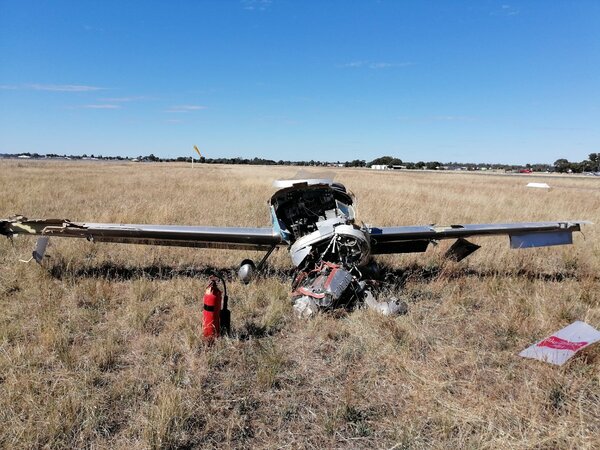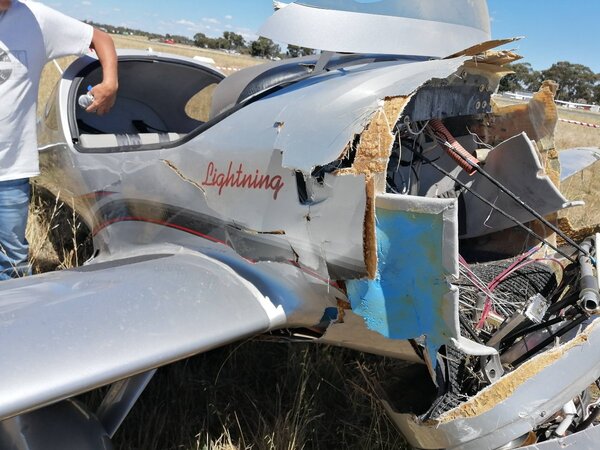
Thexder
-
Posts
17 -
Joined
-
Last visited
-
Days Won
2
Content Type
Profiles
Forums
Gallery
Downloads
Blogs
Events
Store
Aircraft
Resources
Tutorials
Articles
Classifieds
Movies
Books
Community Map
Quizzes
Posts posted by Thexder
-
-
1 hour ago, turboplanner said:
With the information available so far, I wouldn't be ready to heap all the blame on the pilot.
We don't have an official wind direction at the time he took off; as you say other aircraft were landing downwind earlier, and if there was a pattern to the circuit formatted on the downwind runway, the pilot could have been pressured into not upsetting the apple cart and calling for a circit change or a takeoff on 36.
I would say the decision to take off downwind was significant because there was a reasonably forseeable risk in doing so.
If he was coerced into making that decision, then the people involved in that may share some of the blame.
If no one was in charge of the airport, that's a concern too given more than one aircraft was taking off downwind.
This accident is similar in some ways to the Ferris wheel accident in NSW where a judge decided who was at fault
Briefly
A pilot landed on a downwind runway, attempted a go round but couldn’t achieve altitude and crashed into a Ferris Wheel which had been erected in the Runway splay.
The Plaintiff sued to Council and Pilot.
The Pilot sued the Council
The Judge awarded $1.5 million to the Plaintiff, deciding that the Pilot’s share was 35%
The Pilot’s claim against the Council was unsuccessful.
The Court held that the harm suffered was the materialisation of an obvious risk of a dangerous recreational activity as found in Section 5L of the Civil Liability Act (a NSW Act).
Law Firm Chamberlains write a summary of the case:
In this link take particular note that there was a reasonably foreseeable risk, and who had the Duty of Care to eliminate that risk.
https://chamberlains.com.au/local-council-sued-following-aircraft-collision-with-ferris-wheel/
This case is not likely to attract similar claims since no one was hurt, but it does show that Club Members and Council are at risk if things go wrong.
You know what, I've just realised that you are right and I get the feeling you always have been right and always will be right.
You know more about the crash and culpability than I ever could... Heck I only witnessed it with 10 other pilots and spoke to the actual pilot of the crash. What the hero would I know.
Lord turboplanner, I submit to your superior intellect and judgement. Case closed.
-
1 hour ago, turboplanner said:
With the information available so far, I wouldn't be ready to heap all the blame on the pilot.
We don't have an official wind direction at the time he took off; as you say other aircraft were landing downwind earlier, and if there was a pattern to the circuit formatted on the downwind runway, the pilot could have been pressured into not upsetting the apple cart and calling for a circit change or a takeoff on 36.
I would say the decision to take off downwind was significant because there was a reasonably forseeable risk in doing so.
If he was coerced into making that decision, then the people involved in that may share some of the blame.
If no one was in charge of the airport, that's a concern too given more than one aircraft was taking off downwind.
This accident is similar in some ways to the Ferris wheel accident in NSW where a judge decided who was at fault
Briefly
A pilot landed on a downwind runway, attempted a go round but couldn’t achieve altitude and crashed into a Ferris Wheel which had been erected in the Runway splay.
The Plaintiff sued to Council and Pilot.
The Pilot sued the Council
The Judge awarded $1.5 million to the Plaintiff, deciding that the Pilot’s share was 35%
The Pilot’s claim against the Council was unsuccessful.
The Court held that the harm suffered was the materialisation of an obvious risk of a dangerous recreational activity as found in Section 5L of the Civil Liability Act (a NSW Act).
Law Firm Chamberlains write a summary of the case:
In this link take particular note that there was a reasonably foreseeable risk, and who had the Duty of Care to eliminate that risk.
https://chamberlains.com.au/local-council-sued-following-aircraft-collision-with-ferris-wheel/
This case is not likely to attract similar claims since no one was hurt, but it does show that Club Members and Council are at risk if things go wrong.
You know what, I've just realised that you are right and I get the feeling you always have been right and always will be right.
You know more about the crash and culpability than I ever could... Heck I only witnessed it with 10 other pilots and spoke to the actual pilot of the crash. What the hero would I know.
Lord turboplanner, I submit to your superior intellect and judgement. Case closed.
-
 1
1
-
 2
2
-
-
2 minutes ago, MattP said:
Yep, it's judgement, sometimes you can't have it perfect so you choose the least bad option. Slope, terrain, runway length. This was all covered at ppl with da consideration, w&b in theory and then practically. Is this still taught or part of a syllabus?
Yes it is still taught on PPL (not sure about RAaus).
I've taken off plenty of times with a tailwind... Downhill runway, rising terrain, more usable runway, no trees or powerlines etc etc.
-
 1
1
-
-
To be honest, the pilot taking rwy 18 at Shepparton with a 5kt quartering tailwind was not a terrible decision.
Shepparton's runway 36 has virtually no safe landing zone in the event of an emergency/engine out.
Rwy 18 has plenty of safe landing options.
5kt tail wind toward open paddocks instead of 5kt headwind into a housing estate is not a terrible decision... Unless you stall due to lack of airspeed...but 5kt is not a deal breaker.
-
 1
1
-
 1
1
-
-
30 minutes ago, Yenn said:
Taking off downwind is always a poor decision.
I'll meet you at Mt Beauty airport and watch you take off with a 5kt headilwind on runway 14....into steep climbing terrain.
No thanks, 5kt tailwind and taking rwy 32 is the correct decision.
So tailwind is not always a poor decision.
-
 3
3
-
 1
1
-
-
Just now, turboplanner said:
Anyone know what the duty runway was at the time and who was in charge of the airport?
Again, I was there at the time, I am a member of the club that runs out of this council owned airport.
This is not a controlled airport, so that means pilots use their discretion as to any decision they make. No one was in charge of the airport, that's not how it works.
Earlier planes were using runway 18 to land as the wind was light and variable, but technically it was favouring 36. I would say this pilot just followed what other people did earlier and decided to use 18 (I'm speculating here).
The ERSA actually says that 18 is preferred in nil wind and this is because there are few safe places to land in the event of an engine out when taking off on 36 due to housing developments.
Once again this is one of those crashes where no single one factor caused it, it was a combination of many individual decisions and actions (the Swiss cheese analogy)
-
 2
2
-
 1
1
-
-
37 minutes ago, onetrack said:
If you make a number of wrong decisions when in control of an aircraft, resulting in a crash, then one has to consider whether the pilot has adequate competency, and needs more training.
You have already listed around three "poor decisions", or "mistakes" on the pilots behalf, in your clear and precise description of the crash sequence.
I may be considered a little harsh in my summation here, but IMO, the Arion pilot lacks adequate competency.
The fact that he kept pulling back on the stick when he was almost stalled, is a classic error that has killed many people, and shows panic, or a lack of understanding, assuming a superior position over competent aircraft control.
He could have had poor training, maybe he wasn't even compliant with his Biannual Flight Review (BFR) who knows, but simply blaming poor training is not correct. One could have had perfect training, but became complacent or even totally negligent due to poor attitude, but that isn't poor training.
It seems he only purchased the plane ~7 months before the crash and in that time it looks like it was re-painted with other internal works done, so you may be correct in that he lacked adequate competency for the aircraft type. That is not poor training necessarily, as he may not have had a single lesson in the aircraft. That is poor attitude and decision making, not poor training.
Many pilots stall aircraft, for a variety of reasons, but poor training is very very rarely ever a causal factor. Stress is usually the most common fact and I would suggest this may also be the case in this accident. New aircraft, yawing to the left on take-off roll, stressed he pulled back too far on the stick and stalled.....On the internet 2 days later, it's an easy fix. Push the nose down and gather airspeed. In the reality of the moment, they guy made an obvious mistake and luckily he didn't pay the ultimate price.
-
 4
4
-
-
18 minutes ago, Flightrite said:
It always comes back to poor training. The plane driver said he was losing directional control, a well disciplined trained plane driver would have aborted the take off instead of yanking it off the ground, poor training. Stalling and not understanding what constitutes a stall and how to get out of it, poor training!
There will always be plane drivers who think they know better, but with rigorous check flights when due (other than more box ticking during a Flight review) would show them up most times!
I'm sorry, but poor decision making is not poor training. A pilot choosing the wrong runway or choosing not to abort a take-off is not poor training, it is poor decision making.
The pilot would likely have known how to recover a stall, this is basic 101 training, but in the moment he may have panicked and make a poor decision. This is not poor training.
-
 1
1
-
 2
2
-
-
2 minutes ago, turboplanner said:
you didn't think trying to take off downwind might be significant?
It possibly was a significant factor in this case, if he took off prematurely, but generally taking off with a 5 knot tailwind on a 1,298m runway should not be a significant contributing factor.
As a general rule I would just increase my rotation speed by the tailwind component, lift off gently, keep the nose lower to get more air over the wings and generate more lift.
This really shouldn't have been a major factor, but probably was given his apparent slow airspeed and abrupt pulling back of the elevators....another one of those chain of events rather than any single one factor.
-
 1
1
-
-
39 minutes ago, Flightrite said:
Shame it’s not a lot harder to get a plane drivers ticket! I’ve always said it’s too easy! Too many crash/die due poor quality “tick the box” training! I hope the driver learned a very valuable lesson, and others!
In my personal opinion, its not the lack of training, its that pilots are human and therefore make mistakes, become complacent and start to bend the rules....I've seen many 1,000+ hour pilots do silly things because "I've got a thousand hours and the rules don't apply to me".
I've seen guys take-off 20kg over weight because "I've got a big engine and she'll lift anything" when they haven't considered the forces on the plane during turbulence, or guys think the yellow arc on the ASI is the turbulence penetration speed.
-
 1
1
-
-
14 minutes ago, turboplanner said:
A lot of smartass comments here, but not a lot of facts yet; you'd think that's what you would get from skilled pilots, CFIs, Airport Managers, and the pilot involved.
When you say "facts" do you mean like Facebook fact checker facts, or facts from someone who was there, witnessed the crash and spoke to the pilot confirming exactly what happened?
-
 1
1
-
 2
2
-
-
9 minutes ago, turboplanner said:
A lot of smartass comments here, but not a lot of facts yet; you'd think that's what you would get from skilled pilots, CFIs, Airport Managers, and the pilot involved.
Settle princess...that time of the month?
-
 1
1
-
 1
1
-
 2
2
-
-
12 minutes ago, facthunter said:
Not everyone that drives a car can fly a plane. Nev
It turns out that not everyone who fly's a plane can fly a plane......
-
 1
1
-
 5
5
-
 1
1
-
-
Just now, kgwilson said:
I can imagine a couple of Petrol headed boguns discussing this. One turns to the other & says "Why didn't he just plant his boot & drop the effin clutch, wouldn't've stalled then, effin wanker."
Ironically, there was a car show on at the airfield with 50+ classic cars on display....no doubt this very discussion was had by the car boffins who witnessed it.
-
 1
1
-
-
1 hour ago, kgwilson said:
That explains the wreckage a lot. If it had been an engine failure so long as the pilot was competent and got the nose down quickly the aircraft would likely still be in one piece based on the flat terrain & dry grass. A stall at 100 feet or less is going to end in a pretty hard smack into the ground. The Lightning is pretty slippery & I assume WOT at stall. Not enough height to recover, but really good that the nose & engine absorbed a lot of the energy to allow the pilot to walk away.
As they say any landing you can walk away from is a good landing. Of course it was not a great landing because the aeroplane can not be used again.
That is a pretty perfect summary of what happened. Luckily it hit canopy up and the engine took the full force of the impact and thus he was able to walk away.
Like I said, I witnessed it and spoke to the pilot afterward and this is what happened:
- Quartering left tailwind on takeoff (~5 knots)
- He said lots of right rudder used as left turning tendencies were taking him off the left side of the runway
- He pulled back on the stick prematurely to get off the ground and avoid runway excursion
- He mistakenly pulled back harder as the plane was buffeting near stalling (assumed a mistake in panic)
- The plane wing rolled to the left turning him 180 degree as his wing scraped the ground and then his prop hit the ground
Other factors that I can see are that this appears to be a near new plane to him, slippery laminar flow wing, poor choice of runway with the quartering left tail wind.
Truly amazing he hopped out and walked away with but minor bruising on his shins.....very lucky man!
Note: Jabiru engine was not a contributing factor and news media reporting 'engine stall' was laughable.
-
 2
2
-
 3
3
-
-



Arion Lightning EFATO at Shepparton Airport 6/2/22
in Aircraft Incidents and Accidents
Posted
You know what, I've just realised that you are right and I get the feeling you always have been right and always will be right.
You know more about the crash and culpability than I ever could... Heck I only witnessed it with 10 other pilots and spoke to the actual pilot of the crash. What the hero would I know.
Lord turboplanner, I submit to your superior intellect and judgement. Case closed.